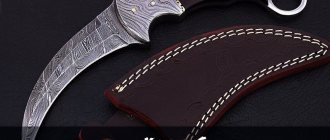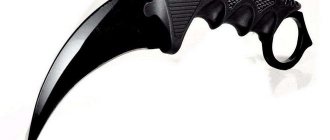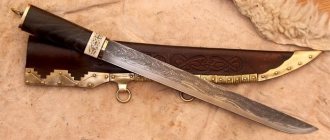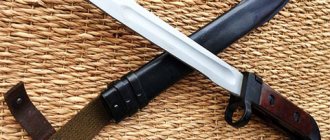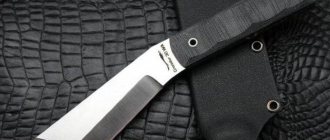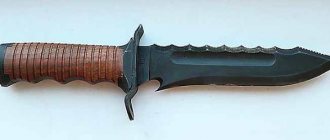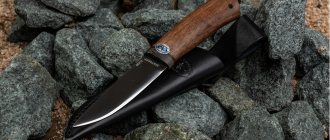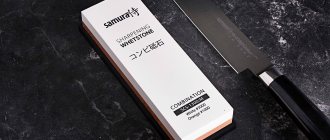Articles
All photos from the article
This article is about how to make a karambit from plywood: drawings and dimensions of a knife are easy to find online, but the technology for processing plywood to give the material maximum strength and an appearance that imitates a real weapon is unknown to many. It is to this that we will pay special attention.
Plywood karambit knife.
What it is and design features
Karambit is considered a knife intended for self-defense. The non-standard, aggressive form is perfect for delivering blows that injure tendons, arteries, muscles, through cutting and stabbing wounds. Moreover, blows can be applied from bottom to top, ripping open the enemy. Blade characteristics:
- A sickle-shaped blade (8 cm) with teeth without a guard, has a double-sided sharpening, along with a spine (5.4 mm thick) and teeth.
- The shape of the knife can be the letter “C” or “G”, length 20 cm, weight 156 g.
- This weapon has a universal reverse grip.
- The handle has a large round hole for your finger to better hold the knife in your hand. With the help of this hole, the knife can be easily maneuvered, making it completely invisible.
- Karambit is characterized by a longitudinal cut on the blade, which can be used to grab knives from the enemy.
Karambit comes from the distant Malay Archipelago, from the Asian islands. There, its exact name among the locals, karambit, means “tiger’s claw.” The term itself speaks about what consequences can occur after using the blade, and the appearance really resembles a tiger’s claw.
Origin
Karambit comes from Sumatra, one of the Asian islands, where it was compared to a tiger's claw.
Indeed, the external resemblance of the blade is easily traced, and the blows inflicted by the weapon resemble the swings of the paw of an angry animal.
Its historical origin is still unclear. There are two main options. The first is that it was used in cockfights, tied as spurs so that the rooster would injure its opponent.
The second was a formidable hunting and combat knife of warriors from Malaysia. None of the options have been proven. The photo below shows what the prototype of a modern karambit looks like.
From the history
This unique weapon has a rich history. The earliest mentions of karambit date back to the 12th century. But it is impossible to know the true history; it is shrouded in legends.
According to one of them, in parts of Indonesia, the local people had a cult of the tiger. People considered him a formidable jungle dweller. They thought that when they died, the souls of their kings transmigrated into the tiger. And the local population began to make combat knives, copying the appearance of a tiger claw. According to other versions, the blade originated either from the demon Bima, whose main weapon was claws, or from the king of the monkeys, who had a magical claw in his palm.
Most likely, the actual prototype of the blade was an ordinary sickle, and the hole was a necessity so that the object would not accidentally fall out of the hand. In these areas, the most common work was in the rice fields - in the water.
In ancient times, it was common on the Indonesian islands to smear the blade with strong poison. As a result of a small, lacerated wound, the enemy died instantly.
Along with heavy types of karambits, there were small ones - for domestic needs and self-defense.
The blade was made like this:
- carbon steel;
- the handle was made of wood or from the horn of an animal;
- the scabbard was made of wood, decorated, but did not have pendants; the blade was intended to be worn in the belt.
Karambit became the prototype of the Bulang blades, which were tied to the legs of roosters in cockfights.
DIY knife prototype
It is impossible to make the original of this weapon under normal home conditions. But it’s not difficult to make a homemade knife from cardboard or any thick paper. This toy can only be given to a child for use in games:
The creation principle is quite simple:
- You need to make a drawing of the weapon being manufactured (for this you can download a full-size photo from the Internet).
- Cut out a couple of paper blanks and glue them together.
- Give the edges the desired relief and shape.
- Cover with putty and sand.
- For visual beauty and similarity to the original, varnish.
If you wish, you can find a video of making a knife on the Internet.
If you need an original knife made of high-quality steel, you can look for it in stores or on the Internet. The range is now very wide. In order not to stumble upon a fake, you need to choose trusted sellers. In addition, as a gift you can choose not an ordinary training karambit, but a collectible model. This souvenir will definitely please a true lover of edged weapons.
Among lovers of edged weapons, there will undoubtedly be those who like the karambit knife. With proper care, such bladed weapons will last for many years, and if desired, they can even be passed on by inheritance. The presence of this knife will easily emphasize the masculine qualities of its owner.
Karambit knife Tiger Claw.
Advantages and disadvantages
The traditional form of karambit has many advantages:
- One of the positive properties of the blade is its invisibility in the hand and a comfortable, and most importantly, reliable grip. Thanks to this, the appearance of a blade in a fight will always be unexpected for the enemy.
- It is almost impossible to knock a karambit out of your hand.
- Blades intended for self-defense differ from classic military blades; they are smaller in size. The length of the blade is shorter, and the design itself is simplified.
- The blade can be used equally with a forward and reverse grip.
- During the battle, thanks to the ring, the karambit can be twisted as you like, thereby distracting the enemy and confusing him. Due to the increased maneuverability of the blade, the possibility of delivering damaging blows to the enemy increases.
Do not forget about some disadvantages, this product has them:
- The shape of the blade can be considered a disadvantage; it is inconvenient for urban residents. But now this flaw is being corrected by making folding - pocket models. Some manufacturers have developed a mechanism on the butt in the form of a hook for karambits. It creates an automatic opening of the blade when removed from the pocket.
- The utility blade is very difficult to sharpen.
- Direct piercing blows cannot be delivered with a karambit due to its curved contour.
- This design is difficult to remove and insert into the sheath, and this is important for self-defense.
The shape of the blade is well suited for use on the farm; thanks to the bend, the knife easily cuts branches, ropes, and surfaces.
What types of karambit are there?
As a rule, there are two main types of these weapons:
- With a fixed blade.
- Folding.
It is more convenient to carry a folding karambit knife; the clip adds convenience; with its help you can carry the knife on your belt. For folding karambit, special small and lightweight plastic holders are made.
And for a non-folding model, the manufacture of a unique sheath is required. The knife case is made of soft leather so that it can be easily and firmly put on. While the blade is inside the case, the ring remains on the outside.
Where is karambit used today?
Today the blade is widespread among the countries of the Malay Archipelago as:
- self-defense weapons;
- attribute in military combats;
- household knife.
In the West and in the USA, karambit became known only at the end of the last century, at demonstrations of martial arts from Asia. After this, the karambit boom began in the world, and its development in the Western industry was expressed in:
- traditional blade - for use in martial arts;
- the use of specific elements from the blade in modifications of other types;
- combining elements from karambit with other elements of famous knives.
In the USA, karambit is one of the favorite blades. It is worn by police officers and used as a training element in hand-to-hand combat.
For self-defense, a knife is usually used in close combat, on a counterattack. The goal is to strike the enemy’s limbs in order to “incapacitate” them, but not cause significant damage to health.
By standards now in Russia, a blade is not a bladed weapon, since its blade is less than 9 cm. People take karambit with them:
- for fishing and hunting - for gutting game, fish, skinning animals;
- on trips, hiking trips - to cut firewood, twigs, ropes, food;
- for self-defense.
Techniques with karambit
Techniques for fighting with karambit have not been specially developed by anyone; the knife can be used as an independent or auxiliary weapon. In the first case, a thrust/strike is first performed with the sharp end of the blade, then the hand must perform an open “figure eight” - this is how cutting blows are applied.
If karambit is used as an auxiliary weapon, then the fighter uses his free hand to grab the enemy and strike him. It must be taken into account that the Malaysian knife is used only in close combat, so the fighter must constantly move and work like a pendulum. During the battle you can strike:
- Karambit knife from China. A gamer's delight or a real tool?
- cutting;
- straight point;
- ring (the protrusion on it is very painful).
The tip of the blade can be used to make holds and hooks. In general, you need to constantly be on the move and attack the enemy from all sides, in all directions, without interruption.
How to do it yourself
You can try to make such a beautiful blade yourself from paper, cardboard, plywood and wood. You will get an exact copy of the blade, as in the popular computer game. It is imperative to perform all actions in order to avoid mistakes.
Create a drawing
Before creating a drawing of a karambit knife, select the model you want to make. Dimensions are taken. If you wish, you can find a ready-made drawing of the blade and print it or trace it along the contours directly on the monitor screen. A simple drawing is drawn on paper on a scale of 1:1. For this, a sheet of thick paper with A4 format will be enough.
Making a knife
Making a popular knife with a drawing is quite simple. Now you need to prepare the materials for the work from which the knife and tools will be made.
From paper
To work you need to prepare:
- several sheets of paper, the color can be any desired; for contrast, the handle can be made in a different color;
- scotch;
- marker;
- pencil;
- scissors and PVA glue or hot melt glue.
Making a blade from paper is done step by step:
- In the drawing, the knife is divided into three parts: the blade, the handle to the ring and the ring.
- Cut out these three parts carefully with scissors.
- To make the handle, fold a sheet of A4 paper in half, then in half again (1/4), and again (1/8) to make a rectangle out of the paper.
- Apply the handle template to the folded paper so that the top of the template is on the top solid part of the fold of the sheet. Trace with a pencil and cut along the contour, without touching the upper solid part of the fold.
- The resulting “book” of eight leaves is glued together. The middle doesn't stick together. It turns out a handle with a bend.
- Glue the handle completely, except for 3 cm along the edge where it joins the blade. This part remains to strengthen the edge.
- To make a knife blade, fold the paper in the same way as in step 3 for the handle.
- The template is traced according to the same pattern as that of the handle and cut out, after adding 2 cm at the wide part for easy joining with the handle.
- Glue the parts except the middle.
- To fasten, take a square sheet of paper, place a thin rod from a pen on the edge and roll the paper along the rod into a thin tube. Twist the tip of the paper and glue it with tape so that everything does not unravel.
- The rod is removed from the resulting structure, the workpiece is smoothed with your fingers and 2 pieces of 10 cm and 5 cm are cut off - these are the fastenings for the blade and handle.
- The blade is connected to the handle using fasteners and glued together.
- For the third part of the ring, form the same structure as in step 10. Only from it the ring is twisted and glued to the handle.
Made of wood
The option of making karambit from wood is complex, it is suitable for those who have skills in working with wood. The type of wood suitable for work is linden. The size of the workpiece should be slightly larger than the future dimensions of the knife. The linden must first be dried; it should not have cracks or holes from knots. To work you will need:
- drills of different sizes;
- chisels of different shapes;
- vice;
- different knives with carbon steel blades.
When making a blade from wood, they use a sketch drawing, as well as their spatial imagination:
- The drawing is transferred to cardboard, a template of three parts is cut out: the main part of the blade and handle and two shaped attachments.
- The template is transferred to a wooden blank and cut out.
- The handle hole is cut with a feather drill or jigsaw.
- The finished parts are glued together with PVA glue and clamped in a vice for a day until dry.
- The last thing to do is sanding until completely smooth.
Coloring
The finished model of the knife can be painted like a real karambit for role-playing. Options are selected at will from the popular computer game, which was mentioned at the beginning of the article Counter-Strike: Global Offensive. Acrylic paints are chosen for painting. They have advantages:
- they do not get dirty and dry quickly;
- paints are harmless.
The most popular blade coloring options:
- Murder and Bloody Web - in black and red;
- Tiger tooth - the blade and ring are painted to resemble the skin of a tiger;
- Gamma wave – black malachite color, and many others.
Using the skins system, it’s easy to stylize this blade.
Gamma wave
Bloody Web
Tiger tooth
Buy or make?
At the moment, you can find knives for every taste and budget; you can come across drawings of a knife made of plywood and plastic for those who are committed to making believable dummies. However, you can purchase a low-quality fake, even if you ordered a decorative version. There is nothing more reliable than an item made by the owner himself.
How to repair kitchen knives
Very often the handle of a favorite item breaks. Don’t rush to throw away your convenient blade; take some time to repair it.
Find a small piece of moisture-resistant plywood large enough to make the handle. Two fragments measuring 18x3x1 cm will do.
Also stock up on self-tapping screws, liquid nails glue, a file, emery cloth, varnish or paint:
- An original handle for a knife made from plywood with your own hands will be ideal if you initially make a template of the blank from paper or cardboard.
- Transfer the outline to the plywood dies, tracing the template with a pencil. You should end up with two identical wooden halves.
Marking the handle mounting points.
- The blanks are cut out and applied to the blade. Don't forget to mark where the screws will fit.
- To prevent the plywood knife from falling apart in your hand, the inside of the dies is smeared with glue, then a “sandwich” is assembled from the halves and the blade.
- The fitted parts are fastened with self-tapping screws and clamped in a vice for about a day. You can put the semi-finished product under a heavy press.
- After the glue has completely dried, the handle is finished with a file and emery cloth.
The photo shows the finished pen.
- In relation to household knives, the instructions advise covering the finished product with waterproof varnish or painting.
Note! Instead of fastening with self-tapping screws, you can rivet the handle. But the method is not available to everyone and is not so reliable. Threaded screws are held tighter, their heads are recessed and cleaned.
Legal assistant
Among the knives allowed by law to be worn and not considered edged weapons (with a blade length of up to 9 centimeters), there are also quite original and useful specimens. They have an affordable price and interesting appearance. For example, this is the “butterfly” of Filipino origin (the original name is “balisong”), the Malaysian-Indonesian knife “karambit” and the Nepalese “khukri”.
The last two have a strongly curved claw-shaped blade; the handle is often equipped with brass knuckles. The butterfly got its name thanks to the handle that extends in both directions, in which the blade is hidden when folded. When the arms open, they resemble wings.
Base: thin plywood
It is enough to simply cut karambit from several pieces of plywood, then glue them together, sand and paint. This work resembles a children's pyramid - the middle of the knife is the largest part, then parts are located evenly on both sides, decreasing in scale. Such a toy will be quite safe, but quite realistic. The graphic layout of the karambit is shown in the figure.
And here are the individual parts indicating the thickness of the material used and the number of pieces.
What is the price of karambit
It is not possible to definitively answer the question about the price of karambit, since manufacturers choose different metals to create it. Also, the price depends on the technique in which it is made.
On average, you can count on 35-40 dollars, for this price you can get a small folding knife, but if the buyer is willing to pay 450-500 dollars, then you will receive a high-tech and branded product. Often the price varies depending on the company and brand that creates it, as always - the more popular the brand, the more expensive the knife will cost.
Karambit knife in hand.
Karambit-like knives
Year after year there are masters who try to improve the karambit knife. Of course, after modernization, the knife acquires new elements and becomes more of a karambit-like knife, the functions of which are not actually changed, but the appearance is different.
What are the famous karambit-like knives:
- Taji is the common name for knives that are intended for cockfighting. This “amusing” business dates back to Indonesia, where knives were attached to the paws of roosters using red string. Taji knives are razor-sharp and their length is from 10 to 15 cm. Craftsmen make entire sets of 6-12 knives in a set of different lengths, designed for different sizes of roosters. Taji knives are considered not only sports, but also sacred equipment. It is customary to clean Tajis only at night and only for men; women are prohibited from touching them;
- Kuku Mahan literally means “Claw of the Great Tiger”. Its difference from a traditional blade is that it has less curve in the blade;
- Karambit Lavi Ayam is also intended for “cockfighting”. The second name of the blade is “cockspur”;
- Kembar - its difference is that this blade has two blades that are directed in one direction;
- Renkong - has a slight bend in the blade, a small protrusion near the handle;
- Panjang - has a slightly curved blade, with a sharp protrusion on the outside;
- Minang is a sickle-shaped knife with a tiger on the handle or sheath.
Minang sickle knife.
Model assembly
Having cut out all the necessary parts from plywood using a jigsaw, they must be cleaned of dust and degreased. For gluing parts, synthetic glue for wooden surfaces or casein is suitable. It is necessary to use glue strictly according to the instructions so that the model does not fall apart over time. When the karambit has dried thoroughly, a hole for the thumb is drilled or sawed out on the handle. This stage of work should be as careful as possible so that the layout does not break. When everything is ready, the karambit must be sanded with sandpaper and again cleaned of sawdust dust. As you can see, the question of how to make a karambit knife from wood does not have a very complicated answer.
Straight grip
This type of grip is very different from the reverse in that the blade comes out from the side of the thumb, while the little finger is threaded through the ring. People who use the karambit knife in the computer game Counter-Strike are familiar with such techniques. CS GO is a new version of a team shooter that captivates from the first minutes. Here the player can freely use both firearms and bladed weapons, including karambit. Although in real life such a product looks intimidating. It is this kind of “karambit” knife, the photo of which is given below, that is used by gamers in the virtual world.
Basically, a direct grip is used to hold small knives, as well as karambit-like products, which are often used for personal self-defense.
Manufacturing
So, how can you make a fairly reliable imitation with your own hands?
Sawing blanks
Dear reader, do you have a jigsaw? Yes? Great, put it aside and forget about it.
There are two ways to cut a wooden blank of complex shape from plywood 4–12 mm thick:
- Hand jigsaw;
- An improvised cutter, which can be a stationary circular saw or an angle grinder with a saw blade installed. In the latter case, the workpiece is securely fixed with a clamp.
Attention: if you are going to work with a grinder converted into a saw, do not forget about safety glasses and be extremely careful. In particular, you can put the tool on the table only after the disk has completely stopped.
The holes in the handle are selected with a ballerina or a feather drill of the appropriate diameter.
The hand jigsaw is still in demand.
Gluing
Universal PVA glue is quite suitable for it. The price of a small tube that we will need will be no more than 20-30 rubles.
The pieces will have to be glued and dried under pressure:
| Stage | Actions |
| 1 | Apply a layer of glue to the contacting sides of the workpieces |
| 2 | Clamp the product with a wooden clamp or metal vice, under the cheeks of which are placed scraps of plywood |
| 3 | Remove any squeezed out glue as far as a clamp or vice will allow. When it sets, it will be more difficult to get rid of drips |
Grinding
It can be done:
- On a belt or disc sander;
- On sandpaper;
Attention: emery grinds down soft wood very quickly. The workpiece is pressed against it with minimal pressure.
- By hand, on a block covered with sandpaper.
Do not strive for the sharpness of the blade: plywood ground to a razor sharpness will quickly break.
It is better not to sharpen the edges of the blade, but to slightly round it.
Impregnation
It is best to impregnate the blade with bakelite wood varnish to protect it from water. If for some reason it is not available, ordinary drying oil will do just fine. For deeper penetration into the veneer, it is preheated in a water bath.
Painting
Alkyd enamel PF-115 fits well on bakelite varnish. A charcoal black or ball (gray) color will look great on a knife. Over drying oil, plywood can only be painted with oil paint for exterior use.
To give a matte texture, after the paint has dried, the blade is treated with sandpaper - zero.
Sanding gave the painted surface a matte texture.
Tiger Claw
“CS:GO” is a popular computer toy for boys of all ages, over 13-14 years old. Its plot is primitive, but the arsenal used by the heroes amazes the imagination with its vastness. From bladed weapons to firearms, everything is used to complete a rather controversial mission. Among the knives included in the KS-ki collection, as gamers briefly call the toy, the most notable knife is the karambit. It is shaped like a tiger's claw - just as curved and causing the same lacerations. On the handle of the knife there is a round hole for a finger - for a better grip, and also to show off such a weapon, turning it with all sorts of somersaults. You can buy almost real karambit by ordering it in one of the online stores. Or you might wonder how to make karambit from wood with your own hands and find a solution.
